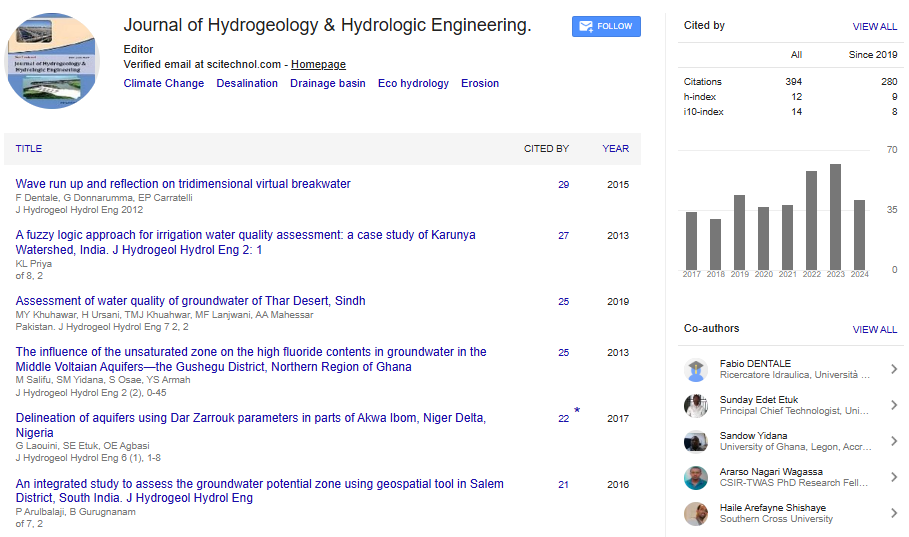Commentary, J Hydrogeol Hydrol Eng Vol: 13 Issue: 5
Hydroinformatics: Revolutionizing Water Management through Data-Driven Insights
Hiroshi Tanaka*
1Department of Hydrologic Engineering, Cheikh Anta Diop University, Dakar, Senegal
*Corresponding Author: Hiroshi Tanaka,
Department of Hydrologic Engineering,
Cheikh Anta Diop University, Dakar, Senegal
E-mail: tanakah25@gmail.com
Received date: 23 September, 2024, Manuscript No. JHHE-24-153109;
Editor assigned date: 25 September, 2024, PreQC No. JHHE-24-153109 (PQ);
Reviewed date: 09 October, 2024, QC No. JHHE-24-153109;
Revised date: 16 October, 2024, Manuscript No. JHHE-24-153109 (R);
Published date: 24 October, 2024, DOI: 10.4172/2325-9647.1000345
Citation: Tanaka H (2024) Hydroinformatics: Revolutionizing Water Management through Data-Driven Insights. J Hydrogeol Hydrol Eng 13:5.
Description
Hydroinformatics is an emerging interdisciplinary field that leverages data science, computer modeling and information technology to solve complex water-related challenges. It merges hydrology, computational modeling and informatics, providing tools and methods to understand and manage water systems efficiently. This field is particularly valuable in the context of global water issues like scarcity, pollution, flood risk and the effects of climate change. Hydroinformatics offers decision-makers powerful insights by transforming raw data into actionable information.
Hydroinformatics combines data from diverse sources remote sensors, satellite imagery, historical records and real-time monitoring systems. This data fusion allows for a comprehensive understanding of water systems, whether it be river basins, urban water networks, or coastal areas. Core elements in hydroinformatics include advanced computer modeling, machine learning and data visualization, all of which allow hydrologists and water managers to predict, plan and manage water resources more effectively.
For instance, models like Hydrologic Engineering Center’s-River Analysis System (HEC-RAS) and Storm Water Management Model (SWMM) are commonly used to simulate river flow, floodplain mapping and urban drainage systems. Artificial Intelligence (AI) and machine learning are increasingly being applied to these models, allowing for better predictions based on past data and real-time environmental conditions. This blending of technologies enables more accurate forecasting and resource management.
Flood prediction and management hydroinformatics is invaluable in flood risk assessment and management. Advanced hydrological models simulate flood events, while data analytics help predict flood severity based on real-time weather patterns. Governments and local authorities use hydroinformatics tools to identify flood-prone areas and implement preventive measures, such as creating flood zones or designing urban drainage systems.
Water quality monitoring pollution and contamination of water bodies are precarious environmental concerns. Hydroinformatics allows scientists to monitor water quality by analyzing data from sensors measuring parameters like pH, temperature, turbidity and dissolved oxygen levels. This real-time data allows for early detection of pollution sources, making it easier to moderate contamination before it spreads.
Urban w ater management urbanization poses unique challenges for water management, particularly in maintaining clean, reliable water supplies and efficient drainage systems. Hydroinformatics offers tools to optimize water distribution networks and sewage systems. Through smart water meters and data analytics, city planners can make informed decisions on water allocation, minimize losses and address water shortages proactively.
Climate change impact analysis climate change has direct and significant impacts on water availability and distribution. Hydroinformatics aids in understanding these impacts through predictive modeling of rainfall patterns, drought occurrences and other climate-related variables. These insights allow policymakers to adopt more resilient strategies for sustainable water management.
Groundwater management hydroinformatics also plays a role in the management of groundwater resources. By integrating data from hydrological models and Geospatial Information Systems (GIS), hydroinformatics tools can map groundwater availability, assess its quality and predict depletion rates. This helps water managers ensure sustainable usage of groundwater, an increasingly important resource in many regions facing surface water scarcity.
The benefits of hydroinformatics are wide-ranging, primarily due to its data-driven approach. Firstly, it promotes informed decisionmaking by providing accurate and up-to-date information. Secondly, hydroinformatics enhances predictive capabilities, which is essential in an era where water resources are under constant pressure from population growth and climate change. Lastly, hydroinformatics tools improve efficiency in water management practices, reducing resource wastage and operational costs.
Despite its advantages, hydroinformatics faces challenges. The accuracy of hydroinformatics models is contingent upon data quality, which varies greatly across regions. Many areas lack reliable monitoring infrastructure, limiting the field’s potential. Additionally, implementing these advanced systems requires substantial investment, both in technology and skilled personnel. The integration of data from multiple sources, such as satellite data and ground sensors, also introduces complexities in terms of data compatibility and standardization.
 Spanish
Spanish  Chinese
Chinese  Russian
Russian  German
German  French
French  Japanese
Japanese  Portuguese
Portuguese  Hindi
Hindi 
